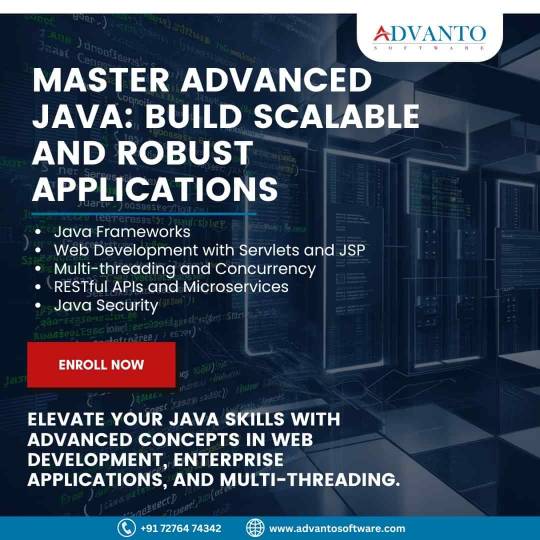#Robust Java Applications
Explore tagged Tumblr posts
Text

Ubuntu is a popular open-source operating system based on the Linux kernel. It's known for its user-friendliness, stability, and security, making it a great choice for both beginners and experienced users. Ubuntu can be used for a variety of purposes, including:
Key Features and Uses of Ubuntu:
Desktop Environment: Ubuntu offers a modern, intuitive desktop environment that is easy to navigate. It comes with a set of pre-installed applications for everyday tasks like web browsing, email, and office productivity.
Development: Ubuntu is widely used by developers due to its robust development tools, package management system, and support for programming languages like Python, Java, and C++.
Servers: Ubuntu Server is a popular choice for hosting websites, databases, and other server applications. It's known for its performance, security, and ease of use.
Cloud Computing: Ubuntu is a preferred operating system for cloud environments, supporting platforms like OpenStack and Kubernetes for managing cloud infrastructure.
Education: Ubuntu is used in educational institutions for teaching computer science and IT courses. It's free and has a vast repository of educational software.
Customization: Users can customize their Ubuntu installation to fit their specific needs, with a variety of desktop environments, themes, and software available.
Installing Ubuntu on Windows:
The image you shared shows that you are installing Ubuntu using the Windows Subsystem for Linux (WSL). This allows you to run Ubuntu natively on your Windows machine, giving you the best of both worlds.
Benefits of Ubuntu:
Free and Open-Source: Ubuntu is free to use and open-source, meaning anyone can contribute to its development.
Regular Updates: Ubuntu receives regular updates to ensure security and performance.
Large Community: Ubuntu has a large, active community that provides support and contributes to its development.
4 notes
·
View notes
Text
Top 5 Programming Languages to Master in 2025
Programming language theory is the subfield of computer science that studies the design, implementation, analysis, characterization, and classification of programming languages.
1. Java
You might ask, “Is Java obsolete?” Of course not.
Why is Java still popular? Java is one of the oldest and most robust programming languages. It is also an object-oriented language mainly used for Android application development. This is one of the main reasons it is still used today. However, with the advent of programming languages like Kotlin (also suitable for Android development), Java is becoming less popular.

2. Swift

3. SQL

4. JavaScript

5. Python

The amazing thing about Python is that it’s a general-purpose programming language used to build a wide range of applications. Furthermore, it is active in artificial intelligence. Self-driving cars, Wal-Mart auto-payment, and many automation and machine learning (ML) apps were developed through Python. This makes this language more important and rapidly popularizes. In addition, Python is easier to learn than all other languages and is easy for beginners. You can also build complex applications relatively easily and quickly. In the United States, the average salary for Python developers is about $ 78,000, while experienced developers can be as high as $ 122,000.
2 notes
·
View notes
Text

Level up your Java expertise! Master advanced concepts to build scalable, robust applications. From web dev to microservices, take your skills to new heights. Enroll now and become a Java pro!
Visit www.advantosoftware.com or call +91 72764 74342 to transform your data into actionable intelligence. Don't just follow trends—set them with Advanto!
3 notes
·
View notes
Text
Java The Language Of Choice Among The Developers
The various factors supportive of Java are the object oriented designing, platform independency, robustness of language, multithreading support, copious standard library and dynamic character all make Java a multipurpose and efficient language. Such popularity in different areas including web applications and mobile development proves its appropriateness in the context of software development. Java always stays updated and develops a community, and it remains the programming language of choice among the developers.
#java#javascript#javaprogramming#javaris x#coding#computerscience#machine learning#programming#python
2 notes
·
View notes
Text
The Roadmap to Full Stack Developer Proficiency: A Comprehensive Guide
Embarking on the journey to becoming a full stack developer is an exhilarating endeavor filled with growth and challenges. Whether you're taking your first steps or seeking to elevate your skills, understanding the path ahead is crucial. In this detailed roadmap, we'll outline the stages of mastering full stack development, exploring essential milestones, competencies, and strategies to guide you through this enriching career journey.

Beginning the Journey: Novice Phase (0-6 Months)
As a novice, you're entering the realm of programming with a fresh perspective and eagerness to learn. This initial phase sets the groundwork for your progression as a full stack developer.
Grasping Programming Fundamentals:
Your journey commences with grasping the foundational elements of programming languages like HTML, CSS, and JavaScript. These are the cornerstone of web development and are essential for crafting dynamic and interactive web applications.
Familiarizing with Basic Data Structures and Algorithms:
To develop proficiency in programming, understanding fundamental data structures such as arrays, objects, and linked lists, along with algorithms like sorting and searching, is imperative. These concepts form the backbone of problem-solving in software development.
Exploring Essential Web Development Concepts:
During this phase, you'll delve into crucial web development concepts like client-server architecture, HTTP protocol, and the Document Object Model (DOM). Acquiring insights into the underlying mechanisms of web applications lays a strong foundation for tackling more intricate projects.
Advancing Forward: Intermediate Stage (6 Months - 2 Years)
As you progress beyond the basics, you'll transition into the intermediate stage, where you'll deepen your understanding and skills across various facets of full stack development.

Venturing into Backend Development:
In the intermediate stage, you'll venture into backend development, honing your proficiency in server-side languages like Node.js, Python, or Java. Here, you'll learn to construct robust server-side applications, manage data storage and retrieval, and implement authentication and authorization mechanisms.
Mastering Database Management:
A pivotal aspect of backend development is comprehending databases. You'll delve into relational databases like MySQL and PostgreSQL, as well as NoSQL databases like MongoDB. Proficiency in database management systems and design principles enables the creation of scalable and efficient applications.
Exploring Frontend Frameworks and Libraries:
In addition to backend development, you'll deepen your expertise in frontend technologies. You'll explore prominent frameworks and libraries such as React, Angular, or Vue.js, streamlining the creation of interactive and responsive user interfaces.
Learning Version Control with Git:
Version control is indispensable for collaborative software development. During this phase, you'll familiarize yourself with Git, a distributed version control system, to manage your codebase, track changes, and collaborate effectively with fellow developers.
Achieving Mastery: Advanced Phase (2+ Years)
As you ascend in your journey, you'll enter the advanced phase of full stack development, where you'll refine your skills, tackle intricate challenges, and delve into specialized domains of interest.
Designing Scalable Systems:
In the advanced stage, focus shifts to designing scalable systems capable of managing substantial volumes of traffic and data. You'll explore design patterns, scalability methodologies, and cloud computing platforms like AWS, Azure, or Google Cloud.
Embracing DevOps Practices:
DevOps practices play a pivotal role in contemporary software development. You'll delve into continuous integration and continuous deployment (CI/CD) pipelines, infrastructure as code (IaC), and containerization technologies such as Docker and Kubernetes.
Specializing in Niche Areas:
With experience, you may opt to specialize in specific domains of full stack development, whether it's frontend or backend development, mobile app development, or DevOps. Specialization enables you to deepen your expertise and pursue career avenues aligned with your passions and strengths.
Conclusion:
Becoming a proficient full stack developer is a transformative journey that demands dedication, resilience, and perpetual learning. By following the roadmap outlined in this guide and maintaining a curious and adaptable mindset, you'll navigate the complexities and opportunities inherent in the realm of full stack development. Remember, mastery isn't merely about acquiring technical skills but also about fostering collaboration, embracing innovation, and contributing meaningfully to the ever-evolving landscape of technology.
#full stack developer#education#information#full stack web development#front end development#frameworks#web development#backend#full stack developer course#technology
9 notes
·
View notes
Text

The Evolution of Programming Paradigms: Recursion’s Impact on Language Design
“Recursion, n. See Recursion.” -- Ambrose Bierce, The Devil’s Dictionary (1906-1911)
The roots of programming languages can be traced back to Alan Turing's groundbreaking work in the 1930s. Turing's vision of a universal computing machine, known as the Turing machine, laid the theoretical foundation for modern computing. His concept of a stack, although not explicitly named, was an integral part of his model for computation.
Turing's machine utilized an infinite tape divided into squares, with a read-write head that could move along the tape. This tape-based system exhibited stack-like behavior, where the squares represented elements of a stack, and the read-write head performed operations like pushing and popping data. Turing's work provided a theoretical framework that would later influence the design of programming languages and computer architectures.
In the 1950s, the development of high-level programming languages began to revolutionize the field of computer science. The introduction of FORTRAN (Formula Translation) in 1957 by John Backus and his team at IBM marked a significant milestone. FORTRAN was designed to simplify the programming process, allowing scientists and engineers to express mathematical formulas and algorithms more naturally.
Around the same time, Grace Hopper, a pioneering computer scientist, led the development of COBOL (Common Business-Oriented Language). COBOL aimed to address the needs of business applications, focusing on readability and English-like syntax. These early high-level languages introduced the concept of structured programming, where code was organized into blocks and subroutines, laying the groundwork for stack-based function calls.
As high-level languages gained popularity, the underlying computer architectures also evolved. James Hamblin's work on stack machines in the 1950s played a crucial role in the practical implementation of stacks in computer systems. Hamblin's stack machine, also known as a zero-address machine, utilized a central stack memory for storing intermediate results during computation.
Assembly language, a low-level programming language, was closely tied to the architecture of the underlying computer. It provided direct control over the machine's hardware, including the stack. Assembly language programs used stack-based instructions to manipulate data and manage subroutine calls, making it an essential tool for early computer programmers.
The development of ALGOL (Algorithmic Language) in the late 1950s and early 1960s was a significant step forward in programming language design. ALGOL was a collaborative effort by an international team, including Friedrich L. Bauer and Klaus Samelson, to create a language suitable for expressing algorithms and mathematical concepts.
Bauer and Samelson's work on ALGOL introduced the concept of recursive subroutines and the activation record stack. Recursive subroutines allowed functions to call themselves with different parameters, enabling the creation of elegant and powerful algorithms. The activation record stack, also known as the call stack, managed the execution of these recursive functions by storing information about each function call, such as local variables and return addresses.
ALGOL's structured approach to programming, combined with the activation record stack, set a new standard for language design. It influenced the development of subsequent languages like Pascal, C, and Java, which adopted stack-based function calls and structured programming paradigms.
The 1970s and 1980s witnessed the emergence of structured and object-oriented programming languages, further solidifying the role of stacks in computer science. Pascal, developed by Niklaus Wirth, built upon ALGOL's structured programming concepts and introduced more robust stack-based function calls.
The 1980s saw the rise of object-oriented programming with languages like C++ and Smalltalk. These languages introduced the concept of objects and classes, encapsulating data and behavior. The stack played a crucial role in managing object instances and method calls, ensuring proper memory allocation and deallocation.
Today, stacks continue to be an integral part of modern programming languages and paradigms. Languages like Java, Python, and C# utilize stacks implicitly for function calls and local variable management. The stack-based approach allows for efficient memory management and modular code organization.
Functional programming languages, such as Lisp and Haskell, also leverage stacks for managing function calls and recursion. These languages emphasize immutability and higher-order functions, making stacks an essential tool for implementing functional programming concepts.
Moreover, stacks are fundamental in the implementation of virtual machines and interpreters. Technologies like the Java Virtual Machine and the Python interpreter use stacks to manage the execution of bytecode or intermediate code, providing platform independence and efficient code execution.
The evolution of programming languages is deeply intertwined with the development and refinement of the stack. From Turing's theoretical foundations to the practical implementations of stack machines and the activation record stack, the stack has been a driving force in shaping the way we program computers.
How the stack got stacked (Kay Lack, September 2024)
youtube
Thursday, October 10, 2024
#turing#stack#programming languages#history#hamblin#bauer#samelson#recursion#evolution#fortran#cobol#algol#structured programming#object-oriented programming#presentation#ai assisted writing#Youtube#machine art
3 notes
·
View notes
Text
My First Java Program: A Journey into Coding

Starting with Java programming can be an exciting journey, filled with discovery, challenges, and a sense of accomplishment. My experience of writing my first Java program was a significant milestone that opened up a world of possibilities in software development. In this blog, I’ll share my journey through writing my first Java program, along with the concepts I learned and the obstacles I overcame.
The Excitement of Starting
When I first decided to learn Java, I was motivated by its versatility and widespread use in developing applications, from mobile apps to enterprise software. I had heard about the power of Java and how it is a foundational language for many developers. After setting up my Java development environment, which included installing the Java Development Kit (JDK) and choosing an Integrated Development Environment (IDE) like Eclipse, I was ready to dive in.
The anticipation of writing my first program filled me with excitement. I had heard many experienced programmers talk about how exhilarating it felt to see their code come to life, and I was eager to experience that feeling myself.
Setting Up the Development Environment
Before I could write my first program, I needed to ensure my development environment was properly configured. Here’s a brief overview of how I set it up:
1. Installing the JDK: I downloaded the latest version of the Java Development Kit from the Oracle website. This included everything I needed to compile and run Java applications.
2. Choosing an IDE: I chose Eclipse as my IDE because of its robust features and user-friendly interface. After downloading and installing it, I was ready to start coding.
3. Verifying the Installation: I opened the command prompt (or terminal) and typed java -version to confirm that Java was installed correctly. Seeing the version number displayed confirmed that I was on the right track.
Writing My First Java Program
With my development environment set up, I was finally ready to write my first Java program. Following the traditional approach, I decided to create a simple “Hello, World!” program. This classic exercise is often the first step for beginners learning any programming language.
Step 1: Creating a New Java Project
In Eclipse, I created a new Java project:
1. File > New > Java Project.
2. I named the project “HelloWorld” and clicked Finish.
Step 2: Creating a New Java Class
Next, I created a new Java class within the project:
1. Right-click on the src folder in the HelloWorld project.
2. Selected New > Class.
3. I named the class HelloWorld and checked the box to include the public static void main(String[] args) method. This method is the entry point of any Java application.
Step 3: Writing the Code
With the class created, I wrote the code that would print “Hello, World!” to the console:
public class HelloWorld { public static void main(String[] args) { System.out.println(“Hello, World!”); } }
Code Explanation
public class HelloWorld: This line defines a public class named HelloWorld. In Java, every application must have at least one class.
public static void main(String[] args): This line declares the main method, which is the starting point of any Java program. The JVM (Java Virtual Machine) looks for this method when executing the program.
System.out.println(“Hello, World!”);: This line prints the string “Hello, World!” to the console. The System.out object is used to output data to the console, and println is a method that prints the text followed by a newline.
Step 4: Running the Program
After writing the code, it was time to run my program and see the result:
1. I right-clicked on the HelloWorld.java file in the Project Explorer.
2. Selected Run As > Java Application.
To my delight, the console displayed the message “Hello, World!” It was a simple program, but seeing the output felt like a monumental achievement. I had successfully written and executed my first Java program!
Learning from the Experience
The process of writing my first Java program taught me several important lessons:
Understanding Java Syntax
Java has a specific syntax that must be followed. This includes rules about naming conventions, the use of semicolons to end statements, and the structure of classes and methods. Understanding these rules is essential for writing valid Java code.
The Importance of the Main Method
The main method is crucial in Java applications. It serves as the entry point, and every program must have it to be executed. Learning this concept helped me appreciate how Java applications are structured.
The Power of Output Statements
Using System.out.println() was my first experience with output statements. It highlighted the importance of feedback in programming. Being able to print messages to the console is invaluable for debugging and understanding program flow.
Overcoming Challenges
While writing my first Java program was largely straightforward, I faced some challenges along the way:
Syntax Errors
Initially, I encountered syntax errors due to missing semicolons or misnamed classes. Each error message provided insight into what I needed to correct. This experience emphasized the importance of careful coding and attention to detail.
Understanding the IDE
Familiarizing myself with Eclipse took some time. I had to learn how to navigate the interface, manage projects, and use features like code suggestions and debugging tools. As I continued coding, I became more comfortable with the IDE.
Next Steps in My Java Journey
Completing my first Java program was just the beginning. With a foundational understanding of Java syntax and structure, I was excited to explore more advanced concepts. Here are the next steps I took in my learning journey:
Exploring Java Basics
I delved deeper into Java basics, including:
Data Types: Understanding primitive and reference data types.
Variables: Learning how to declare and use variables effectively.
Operators: Exploring arithmetic, relational, and logical operators.
Control Flow Statements: Mastering if-else, switch, and loop constructs.
Learning Object-Oriented Programming (OOP)
Java is an object-oriented programming language, and I knew I had to understand OOP principles. I focused on concepts such as:
Classes and Objects: Learning how to create and manipulate objects.
Inheritance: Understanding how classes can inherit properties from other classes.
Encapsulation: Learning how to hide data within classes.
Polymorphism: Exploring method overloading and overriding.
Building Projects
I started working on small projects to apply my knowledge. Simple applications, like a calculator or a text-based game, helped solidify my understanding of Java concepts.
Conclusion
Writing my first Java program was a thrilling experience that marked the beginning of my journey as a programmer. The excitement of seeing my code come to life, coupled with the knowledge I gained, fueled my desire to continue learning and growing in the field of software development.
Java has proven to be a powerful language with endless possibilities, and I am eager to explore its depths further. With each program I write, I feel more confident in my coding abilities and more inspired to tackle new challenges.
If you’re starting your Java journey, embrace the process, celebrate your successes, and don’t shy away from challenges. Each step you take brings you closer to becoming a proficient Java developer.
Happy coding!
2 notes
·
View notes
Text
Spring Boot Interview Questions: Prepare for Success
Spring Boot has become one of the most popular frameworks in the Java ecosystem, streamlining robust and scalable web application development. Whether you’re a seasoned developer or just getting started, acing a Spring Boot interview can be a significant milestone in your career. To help you prepare effectively, here are the latest Spring Boot interview questions that will test your knowledge and give you a deeper understanding of how the framework works. These questions will be beneficial if you're pursuing a Spring Boot Certification Training Course at eMexo Technologies, in Electronic City Bangalore.
1. What is Spring Boot, and how is it different from Spring Framework?
This is a fundamental question that often appears in Spring Boot interviews. Spring Boot is an extension of the Spring Framework to simplify the development process. It eliminates the need for extensive XML configuration and provides default configurations to facilitate rapid application development. Spring Framework requires developers to configure components manually, while Spring Boot auto-configures them.
By understanding this, you can highlight how Spring Boot training in Electronic City Bangalore at eMexo Technologies helps developers focus more on writing business logic rather than dealing with complex configurations.
2. What are the main features of Spring Boot?
Spring Boot stands out due to several features:
Auto-Configuration: Automatically configures your application based on the libraries on the classpath.
Embedded Servers: It allows the deployment of web applications on embedded servers like Tomcat, Jetty, and Undertow.
Spring Boot Starters: Pre-configured templates that simplify dependency management.
Spring Boot CLI: A command-line interface that allows you to develop Spring applications quickly.
Actuator: Monitors and manages application performance.
These features make Spring Boot an attractive option for developers, which is why the best Spring Boot training institute in Electronic City Bangalore emphasizes hands-on experience with these functionalities.
3. What is the role of @SpringBootApplication in Spring Boot?
The @SpringBootApplication annotation is a core part of Spring Boot, often referred to as the ‘meta-annotation.’ It is a combination of three annotations:
@Configuration: Marks the class as a configuration class for Spring Beans.
@EnableAutoConfiguration: Enables Spring Boot’s auto-configuration feature.
@ComponentScan: Scans the components within the specified package.
This annotation is crucial to understanding Spring Boot’s internal architecture and its ability to simplify configuration.
4. What is Spring Boot Starter, and how is it useful?
A Spring Boot Starter is a set of pre-configured dependencies that simplify the inclusion of libraries in your project. For instance, spring-boot-starter-web includes everything you need for web development, like Spring MVC, embedded Tomcat, and validation support.
Starters save a lot of time, as they eliminate the need to find and include individual dependencies manually. When studying at eMexo Technologies, you’ll get an in-depth look at the variety of Spring Boot Starters available and their importance in building scalable applications.
5. What is a Spring Boot Actuator, and how is it used?
Spring Boot Actuator provides production-ready features to help monitor and manage your Spring Boot application. It offers a wide array of tools like health checks, metrics, and auditing endpoints. The actuator allows you to easily monitor application performance, which is a crucial aspect of microservices-based applications.
6. What are Microservices, and how does Spring Boot help in building them?
Microservices are small, independent services that work together in a larger application. Each service is responsible for a specific business functionality and can be developed, deployed, and maintained independently. Spring Boot simplifies the development of microservices by providing tools like Spring Cloud and Spring Boot Actuator.
7. How does Spring Boot handle dependency injection?
Dependency Injection (DI) is a key feature of the Spring Framework, and Spring Boot uses it to manage object creation and relationships between objects automatically. In Spring Boot, DI is usually handled through annotations like @Autowired, @Component, and @Service.
8. How can you configure a Spring Boot application?
Spring Boot applications can be configured in multiple ways:
application.properties or application.yml files.
Using the @Configuration classes.
Via command-line arguments.
Environment variables.
9. What are profiles in Spring Boot, and how are they used?
Profiles in Spring Boot allow developers to create different configurations for different environments. For example, you can have one profile for development, one for testing, and one for production. You can specify which profile to use by setting it in the application.properties file or as a command-line argument.
10. What are the limitations of Spring Boot?
Despite its many benefits, Spring Boot has some limitations:
Lack of control over auto-configuration can sometimes lead to unexpected behaviors.
Increased memory usage due to embedded servers.
Limited flexibility in large-scale applications that require extensive custom configuration.
Addressing these limitations demonstrates that you have a well-rounded understanding of the framework and can make informed decisions about when and where to use it.
11. How does Spring Boot handle security?
Spring Boot simplifies security through Spring Security, which can be easily integrated into your application. By adding the spring-boot-starter-security dependency, you can configure authentication and authorization in a few lines of code. You can also customize login, registration, and session management features.
12. What is the role of the Spring Initializr in Spring Boot?
The Spring Initializr is an online tool used to generate Spring Boot projects. It allows developers to choose the dependencies and configuration options before downloading the skeleton code. This tool speeds up the initial setup phase, saving time and effort.
In conclusion, being well-prepared for Spring Boot interviews is crucial, especially in a competitive job market. Whether you're taking a Spring Boot course in Electronic City Bangalore or aiming for Spring Boot Certification Training, knowing these key concepts will give you the edge you need. At eMexo Technologies, you’ll receive hands-on training, not just theory, preparing you to answer interview questions and excel in your career confidently.
Join Now: https://www.emexotechnologies.com/
#springboot#tech education#certification course#career growth#career development#tech skills#learning#learn to code#software training#emexo technologies#bangalore#technology
2 notes
·
View notes
Text
Which programming language performs better on the web, Java, C#, PHP, or Python?
The performance of a programming language on the web depends on various factors such as the specific requirements of the project, the expertise of the development team, and the scalability of the language. Each programming language you mentioned—Java, C#, PHP, and Python—has its strengths and use cases:
Java: Known for its performance, scalability, and security, Java is widely used in enterprise-level web applications, especially for large-scale projects. It's commonly used in backend development and is favored for its robustness and ability to handle high loads.
C#: Similar to Java, C# is often used in enterprise-level web development, particularly for building applications on the Microsoft .NET framework. It offers strong performance and is well-suited for Windows-based environments.
PHP: PHP is a server-side scripting language specifically designed for web development. It's known for its simplicity, ease of use, and extensive community support. PHP powers a large portion of the web, particularly in content management systems like WordPress and e-commerce platforms like Magento.
Python: Python is a versatile language that is gaining popularity in web development due to its simplicity, readability, and extensive libraries. It's commonly used in web frameworks like Django and Flask, making it suitable for building web applications of various scales.
Ultimately, the best programming language for web development depends on the specific requirements of your project, the preferences of your development team, and the goals of your business. Each language has its advantages and trade-offs, so it's essential to evaluate them based on your project's needs.
4 notes
·
View notes
Text

Java Application Development Services
#Java#Java Application Development#Java Development Services#Custom Java Solutions#Java Web and Mobile Development#Expert Java Development#Java Application Solutions#Custom Java Programming#Mobiloitte Java Services#Professional Java Developers#Java Web Development#Java Mobile Development#Java Software Solutions#Robust Java Applications#Java Development Expertise#Java Solutions Provider#Java Programming Services
1 note
·
View note
Text
Manipal University Online MCA
Conquering the Digital Frontier: Unraveling the Manipal University Online MCA Program

In the whirlwind of the digital age, a Master of Computer Applications (MCA) degree has become the gold standard for aspiring IT professionals. If you crave the flexibility of online learning while seeking the prestige of a renowned university, Manipal University Online's MCA program might be your perfect launchpad. Let's delve into this innovative program, examining its curriculum, eligibility criteria, fees, and the key factors that make it stand out.
Unveiling the Course Structure:
Manipal University Online's MCA program spans across four semesters, meticulously crafted to equip you with cutting-edge knowledge and hands-on skills. Here's a glimpse into the core areas you'll conquer:
Foundational Semesters (Semesters 1 & 2): Laying the groundwork, you'll master programming languages like C++, Java, and Python. Data structures, algorithms, and operating systems will become your playground, while subjects like computer networks and web technologies open doors to the digital world's infrastructure.
Specialization Semesters (Semesters 3 & 4): This is where you carve your niche. Choose from specializations like Artificial Intelligence and Machine Learning, Cloud Computing, Software Development, or Cyber Security. Deepen your expertise in your chosen domain with advanced electives and capstone projects that put your skills to the test.
Eligibility Criteria: Unlocking the Gateway:
To embark on this journey, you must have:
A Bachelor's degree in any discipline with Mathematics or Statistics as a compulsory subject at the 10+2 level or at the graduation level.
Secured a valid score in national entrance exams like NIMCAT, MAT, or ATMA.
A passion for technology and a thirst for continuous learning.
Admission Criteria: Demystifying the Selection Process:
Once you meet the eligibility criteria, your merit score in the chosen entrance exam forms the basis for selection. Shortlisted candidates are then invited for an online interview where your communication skills, technical aptitude, and career aspirations are assessed.
Financial Considerations: Unmasking the Fees:
The program fee for the Manipal University Online MCA program is currently set at around INR 2.5 lakhs per semester. However, scholarships and financial aid options are available for deserving students, easing the financial burden and making the program accessible to a wider pool of talented individuals.
Beyond the Classroom: What Sets Manipal Online MCA Apart:
While a robust curriculum is crucial, Manipal University Online goes the extra mile to elevate your learning experience:
Renowned Faculty: Learn from industry experts and academic stalwarts who bring real-world experience and a passion for teaching to the virtual classroom.
Interactive Learning Platform: Engage in live online sessions, access comprehensive study materials, and collaborate with peers through a user-friendly learning management system.
Industry Connect: Gain an edge with industry internships and mentorship opportunities that bridge the gap between theory and practical application.
Placement Assistance: Leverage the university's strong industry network and dedicated placement cell to land your dream job in the booming IT sector.
Embarking on Your Digital Quest:
The Manipal University Online MCA program is not just a degree; it's a passport to a rewarding career in the ever-evolving IT landscape. If you're driven by ambition, possess a curious mind, and yearn to make your mark in the digital world, this program can be your stepping stone to success.
Spotlight on Specializations: Dive deeper into each specialization, highlighting the specific courses, industry trends, and career prospects.
Alumni Success Stories: Feature interviews with successful alumni who have carved their niche in the IT world after graduating from the program.
Comparison with other Online MCA Programs: Briefly compare Manipal's program with other online MCA offerings, highlighting its unique strengths and value proposition.
Student Testimonies: Include quotes from current or past students about their experiences with the program, its challenges, and its rewards.
Career Outlook: Discuss the job market for MCA graduates, highlighting growth trends, in-demand skills, and potential salary ranges.
Q&A Section: Address frequently asked questions about the program, admission process, and career opportunities.
For further information and updates ,please visit on:-
Top MCA colleges in india with low fees ,visit on :-
11 notes
·
View notes
Text

Improve Your Java Projects with Hosting Home's Java VPS Servers
With Hosting Home’s Java VPS servers, your Java applications get the speed and reliability they deserve. Enjoy top-tier performance, robust security, and expert support tailored for your success.
#java vps#vps java hosting#java hosting vps#vps hosting java#vps java#best vps hosting for java#best java servers#best java web server#tomcat server in java#java server
2 notes
·
View notes
Text
How to Integrate Testing Automation Tools into Your CI/CD Pipeline
Integrating testing automation tools into your Continuous Integration/Continuous Deployment (CI/CD) pipeline is crucial for enhancing software quality and accelerating delivery cycles. The first step is to select the right automation tool that aligns with your technology stack and project requirements. Popular choices include Selenium for web applications, Appium for mobile apps, and JUnit for Java-based projects.
Once the tool is chosen, configure your CI/CD pipeline to include automated testing at various stages. Begin with unit tests during the build phase to catch issues early. Tools like Jenkins, CircleCI, or GitLab CI can be configured to trigger these tests automatically with each code commit. Ensure that the testing environment mirrors the production setup to achieve accurate results.
Next, integrate automated functional and regression tests in the pre-deployment phase. These tests should validate end-to-end functionalities and ensure that new changes do not break existing features. Using frameworks like TestNG or Cucumber can help manage these tests effectively.
Additionally, incorporate performance and load testing tools like JMeter or Gatling to assess the application's behavior under stress. These tests can be scheduled to run during off-peak hours to avoid interference with regular development activities.
Finally, maintain a robust reporting mechanism to track test results and generate insights. Tools like Allure or TestRail can provide detailed reports and dashboards, facilitating quick identification and resolution of issues.
By strategically integrating testing automation tools into your CI/CD pipeline, you ensure a reliable, efficient, and scalable approach to software delivery, ultimately leading to higher quality products and faster release cycles.
#codeless test automation#codeless testing platform#test automation software#automated qa testing#no code test automation tools
3 notes
·
View notes
Text
Techaircraft
💻🚀 Ready to dive into the world of coding? Learn Java programming with us and unlock endless possibilities! 🌟 Whether you're a complete beginner or looking to enhance your skills, our expert-led courses will guide you every step of the way. From mastering the basics to tackling advanced concepts, you'll gain hands-on experience and practical knowledge to build robust applications. 📚💡 Join a community of aspiring developers and take your first step towards a rewarding tech career. 💼✨ Enroll today and start your journey towards becoming a Java pro! . 𝐖𝐞𝐛𝐬𝐢𝐭𝐞 - www.techaircraft.com
𝐓𝐞𝐜𝐡𝐚𝐢𝐫𝐜𝐫𝐚𝐟𝐭 𝐬𝐮𝐩𝐩𝐨𝐫𝐭 𝐝𝐞𝐭𝐚𝐢𝐥𝐬:
𝐌𝐨𝐛𝐢𝐥𝐞 𝐍𝐮𝐦𝐛𝐞𝐫 - 8686069898
#LearnJava#Programming#Coding#JavaProgramming#TechSkills#SoftwareDevelopment#CodeNewbies#ProgrammingLife#TechEducation#CareerGrowth#JavaDeveloper#LearnToCode#TechTraining#FutureDeveloper#ProgrammingJourney

2 notes
·
View notes
Text
Mastering Java's collections allows you to handle data efficiently, write cleaner and more maintainable code, and develop robust applications. The key is to grasp the fundamental concepts, practice with various collections, and use them effectively in your projects.
2 notes
·
View notes
Text
NodeJS excels in web development with its event-driven, non-blocking I/O model, making it ideal for handling concurrent connections and real-time applications like chat apps and live streaming. Its single-threaded architecture and use of JavaScript, both on the server and client side, allow for seamless development across the entire stack. NodeJS is especially suitable for startups and projects that require fast, scalable, and high-performance solutions.
Java, on the other hand, is renowned for its robustness, security, and platform independence. It is a mature technology with a vast ecosystem and a wealth of libraries and frameworks, such as Spring and Hibernate, which facilitate the development of large-scale, enterprise-grade applications. Java's multithreading capabilities and strong memory management make it well-suited for complex, resource-intensive applications where stability and reliability are paramount.
Choosing between NodeJS and Java ultimately depends on the specific needs of your project. For real-time, scalable applications with a need for rapid development, NodeJS is a compelling choice. For enterprise-level applications requiring high stability, security, and comprehensive tool support, Java is often the preferred technology.
#nodejs#javascript#web development#framework#best web development company in usa#software#node js development company#javaprogramming#programming
3 notes
·
View notes